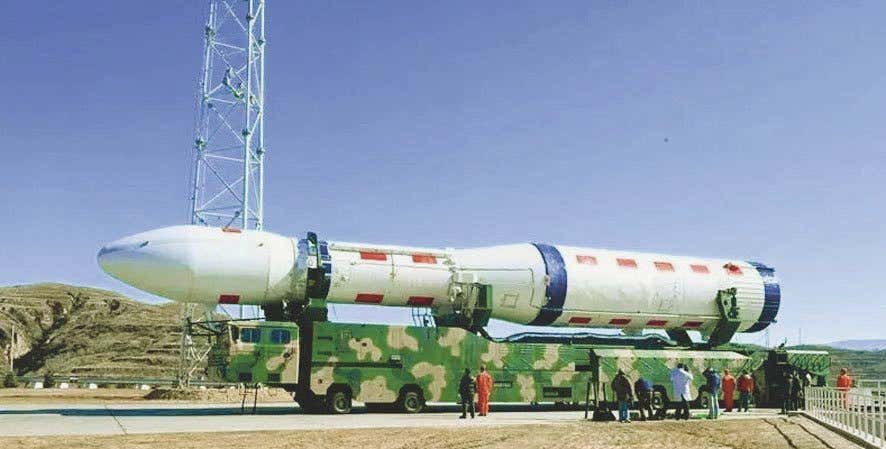China has been working on advancing its anti-satellite weapons (ASAT) program since 2007. Recently, Chinese scientists claimed to have made yet another breakthrough in their ASAT technology.
US’ Hypersonic Ambitions ‘Fail To Boost’; Experts Call It ‘Ominous Signs’ After Series Of Unsuccessful Missile Tests
A large number of ASAT experiments had been conducted by the US and the Soviet Union during the Cold War era. However, these tests were halted by 1980 as they were criticized for producing large amounts of debris which posed risks to valuable space assets as well as the lives of astronauts.
The ASAT test conducted by China in 2007 in which it destroyed a defunct weather satellite with the help of a missile had also faced similar criticism over the cloud space debris created by it.
In the past few years, China’s ASAT program focused on technology, which resulted in little or no debris, such as capturing a satellite using a net or a robotic arm.
The Chinese military also developed several types of ground-based weapons which could blind and even damage a satellite by using a laser beam. However, these methods were easier to detect as compared to the previous ones.
The New ASAT
A group of Chinese researchers has claimed they have successfully built and also tested an anti-satellite robotic device, which could place a small pack of explosives into the exhaust nozzle of a probe.
Instead of blowing up the satellite into a million pieces, this melt-cast explosive was capable of producing a “time-controlled, steady explosion”, Professor Sun Yunzhong and colleagues from the Hunan Defence Industry Polytechnic in Xiangtan wrote in a paper, which was published in the domestic journal called, Electronic Technology & Software Engineering, last month.
As NATO-Russia Tensions Soar, US-Led Military Alliance Sees Gaping Holes In Its Air Defense Capabilities
According to the paper, this project was funded by a government scheme aimed at developing a new type of warhead for rocket missiles. The device can stay inside the satellite for a long period with the help of a locking mechanism which is driven by an electric motor.

In case the device needs to be separated from the target, the process can be easily reversed. It had been developed and tested at a ground facility and researchers say that it “would have practical value in certain engineering applications”.
Since the ground-based ASATs were very easy to detect, Sun’s team had been working towards finding a way of targeting satellites by placing explosives inside them.
In the current device, the explosives have been packed inside a bag weighing only 3.5 kg and has a striking similarity to the shape of de Laval nozzles, which power most of the satellites.
The de Laval nozzles are pipes with a narrow throat in the middle and convert gas into kinetic energy. Even though they are based on a 19thcentury design by Swedish engineer Gustaf de Laval, these nozzles are used on one of the most advanced satellites to date.
Sun’s device works by inserting a rod through this narrow point which results in its opening. The device then securely anchors itself by locking it against the inner wall of the nozzle.
Suspectable footage of intercept over Bayinggola Mongolian A.P., Xinjiang.
(Video Via weibo@天文八卦学家刘博洋) pic.twitter.com/Sf8EKUIHez— Hao Gao (@HaoGao12) February 4, 2021
Once the device is detonated, the explosion will be partially contained inside the nozzle and will be mistaken for an engine malfunction, according to a space scientist who was not involved in this project.
“The heat of the explosion, if precisely calculated, can be partly converted into kinetic energy and damage the satellite’s insides while leaving the overall structure intact,” said another researcher.
‘Grossly Outranged’ By Chinese Air-To-Air Missiles, US Accelerates Development Of New-Age Missiles For Its Fighter Jets
Sun and his colleagues said that the melt-cast explosive had been widely used in China’s space program for separating rock stages and for various other purposes. China has also developed a technology for capturing a satellite, which could also be used for peaceful purposes such as repair and refueling of satellites.
US Military Voiced Concerns
The US military had earlier voiced its concerns regarding China’s ASAT capabilities, particularly the Shijian-17. This was an experimental probe, which had a robotic arm and had carried out a few unusual maneuvers since its launch in the year 2016.
In April, US Space Command chief James Dickinson told Congress that the technology adopted by the Shijian-17 “could be used in a future system for grappling other satellites”. “Beijing actively seeks space superiority through space and space attack systems”, he added.
Comparing ASAT testing:
Number of tests: U.S. (30), Russia (27), China (10), India (1)
Pieces of debris created: China (3280), Russia (878), US (475), India (?)
Debris still in orbit: China (3028), Russia (356), U.S. (0), India (?)
— Dhruva Jaishankar · ध्रुव जयशंकर (@d_jaishankar) March 28, 2019
Furthermore, the rapid development in China’s hypersonic program also fuelled worries about another potential arms race in space. However, earlier this week, Chinese Foreign Ministry spokesmen Wang Wenbin stated that the US has been hyping the “China Threat Theory” so that it could further uplift its own military competence.
China also insists that its military technology is defensive as Wang said, it “will not start an arms race with any country”.
UK Adds Muscle Power To ‘QUAD Strategy’, Enhances Defense Ties With India To Check Chinese ‘Territorial Ambitions’
However, Huang Jia, a researcher at the National University of Defense Technology, said that a new arms race was close and could potentially destroy the environment of space.
“The military aerospace equipment tests essentially use the entire Earth as a laboratory,” Huang wrote in a paper which was published in the Journal of Dialectics of Nature in August. “To avoid tragedy, we need to re-examine the ‘principle of freedom’ in space activities”, he added.
- Written by Kashish Tandon/EurAsian Times Desk
- Contact the author at: kashishtandon21@gmail.com
- Follow EurAsian Times on Google News